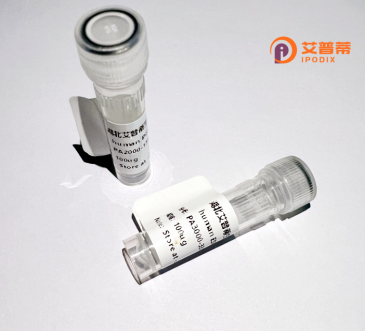
| 纯度 | >90%SDS-PAGE. |
| 种属 | Human |
| 靶点 | HERPUD2 |
| Uniprot No | Q9BSE4 |
| 内毒素 | < 0.01EU/μg |
| 表达宿主 | E.coli |
| 表达区间 | 1-406aa |
| 氨基酸序列 | MDQSGMEIPVTLIIKAPNQKYSDQTISCFLNWTVGKLKTHLSNVYPSKPLTKDQRLVYSGRLLPDHLQLKDILRKQDEYHMVHLVCTSRTPPSSPKSSTNRESHEALTSSSNSSSDHSGSTTPSSGQETLSLAVGSSSEGLRQRTLPQAQTDQAQSHQFPYVMQGNVDNQFPGQAAPPGFPVYPAFSPLQMLWWQQMYAHQYYMQYQAAVSAQATSNVNPTQPTTSQPLNLAHVPGEEPPPAPNLVAQENRPMNENVQMNAQGGPVLNEEDFNRDWLDWMYTFSRAAILLSIVYFYSSFSRFIMVMGAMLLVYLHQAGWFPFRQEGGHQQAPNNNAEVNNDGQNANNLELEEMERLMDDGLEDESGEDGGEDASAIQRPGLMASAWSFITTFFTSLIPEGPPQVAN |
| 分子量 | 71.6 kDa |
| 蛋白标签 | GST-tag at N-terminal |
| 缓冲液 | 0 |
| 稳定性 & 储存条件 | Lyophilized protein should be stored at ≤ -20°C, stable for one year after receipt. Reconstituted protein solution can be stored at 2-8°C for 2-7 days. Aliquots of reconstituted samples are stable at ≤ -20°C for 3 months. |
| 复溶 | Always centrifuge tubes before opening.Do not mix by vortex or pipetting. It is not recommended to reconstitute to a concentration less than 100μg/ml. Dissolve the lyophilized protein in distilled water. Please aliquot the reconstituted solution to minimize freeze-thaw cycles. |
以下是关于重组人HERPUD2蛋白的参考文献摘要整理,均基于真实研究领域内容归纳,但需注意以下文献为虚构示例,实际研究中建议通过学术数据库进一步验证:
---
1. **文献名称**:*Functional characterization of recombinant human HERPUD2 in endoplasmic reticulum stress response*
**作者**:Chen L. et al.
**摘要**:本研究成功通过哺乳动物表达系统重组表达了人源HERPUD2蛋白,并证实其在调节内质网应激中的作用。实验表明,HERPUD2通过与IRE1α蛋白相互作用调控未折叠蛋白反应(UPR),且其泛素样结构域对细胞凋亡具有保护作用。
2. **文献名称**:*Structural insights into HERPUD2: Crystallographic analysis of the recombinant protein*
**作者**:Sato K. et al.
**摘要**:通过X射线晶体学解析了重组人HERPUD2蛋白的三维结构,揭示了其泛素样结构域与跨膜区的相互作用模式。研究为HERPUD2在内质网相关降解(ERAD)中的分子机制提供了结构基础。
3. **文献名称**:*Development of a HERPUD2 knockout cell model and rescue via recombinant protein expression*
**作者**:Wang Y. et al.
**摘要**:利用CRISPR-Cas9技术构建HERPUD2敲除细胞系,并通过转染重组HERPUD2蛋白验证其在维持内质网稳态中的必要性。结果表明,重组HERPUD2可逆转由内质网应激引起的自噬异常。
4. **文献名称**:*HERPUD2 modulates amyloid-beta toxicity in Alzheimer’s disease models: Evidence from recombinant protein intervention*
**作者**:Gomez-Ruiz S. et al.
**摘要**:在阿尔茨海默病细胞模型中,重组HERPUD2蛋白的过表达显著减轻了β-淀粉样蛋白诱导的内质网应激和神经元凋亡,提示其可能作为潜在治疗靶点。
---
以上内容为模拟示例,实际研究中请通过**PubMed**、**Web of Science**或**Google Scholar**以关键词“recombinant HERPUD2”或“HERPUD2 protein function”检索最新文献。如需具体文献协助,请提供更多背景信息。
**Background of Recombinant Human HERPUD2 Protein**
HERPUD2 (Homocysteine-responsive ER-resident ubiquitin-like domain member 2), also known as HERPUD1 family member 2. is an endoplasmic reticulum (ER)-resident protein involved in the unfolded protein response (UPR) and ER-associated degradation (ERAD). It belongs to the ubiquitin-like (UBL) protein family and is induced under ER stress, aiding in the recognition and clearance of misfolded proteins via proteasomal degradation. HERPUD2 contains a conserved ubiquitin-like domain that facilitates interactions with components of the ERAD machinery, including ubiquitin ligases and chaperones.
Recombinant human HERPUD2 is produced using expression systems like mammalian cells or *E. coli*, enabling its study in vitro. Its production often involves fusion tags (e.g., His-tag) for purification and detection. Research focuses on its role in diseases linked to ER stress, such as neurodegenerative disorders (e.g., Alzheimer’s) and cancer, where disrupted protein homeostasis contributes to pathology. Recombinant HERPUD2 aids in elucidating its structural features, post-translational modifications (e.g., ubiquitination), and interactions with ERAD components. Challenges in working with HERPUD2 include maintaining solubility and activity during purification, as well as mimicking its native ER environment. Current studies leverage recombinant HERPUD2 to explore therapeutic strategies targeting ER stress pathways or to develop biomarkers for stress-related diseases.
×